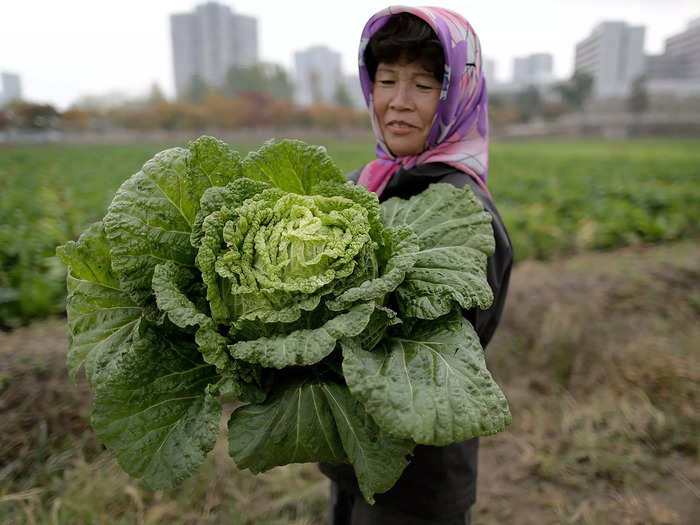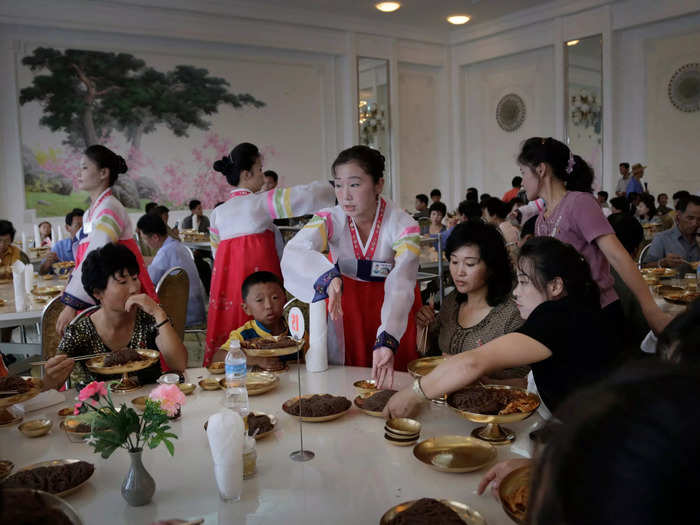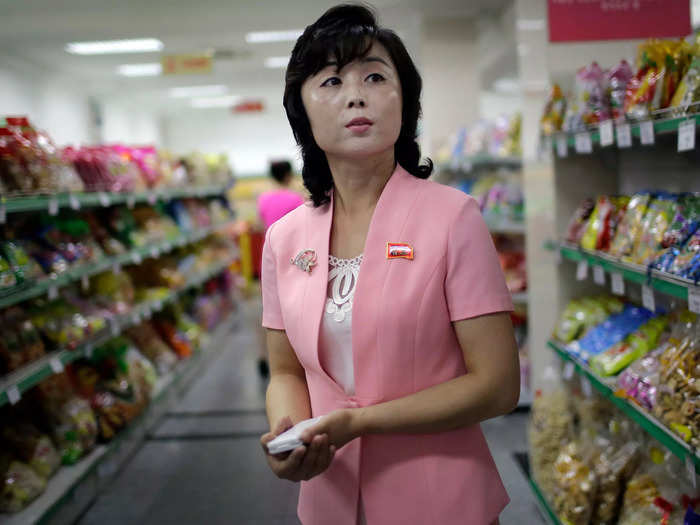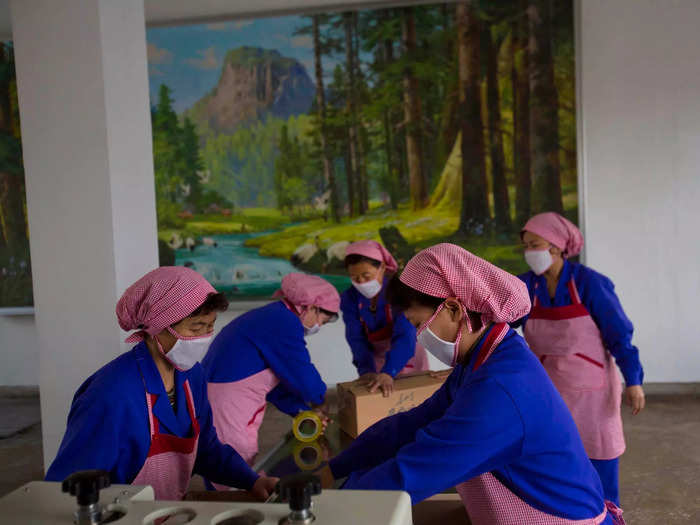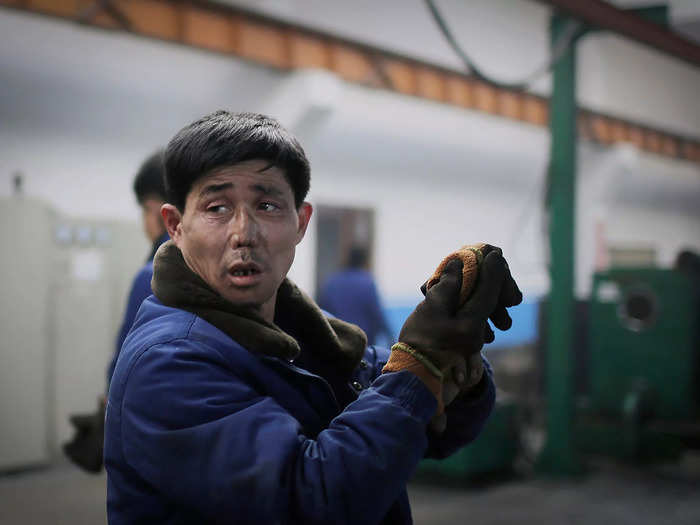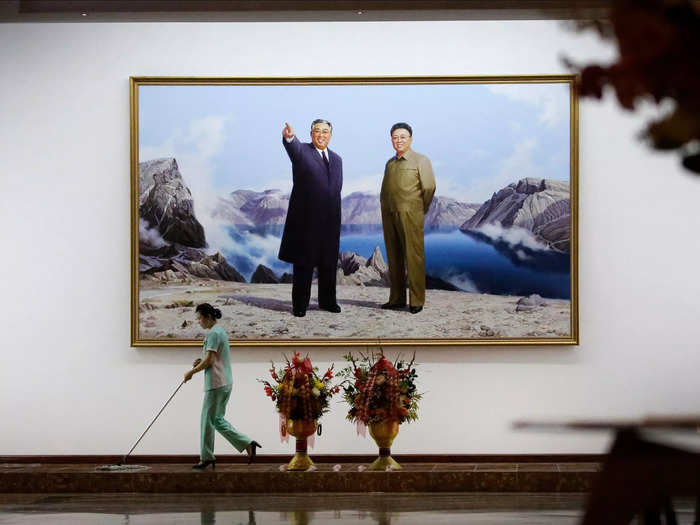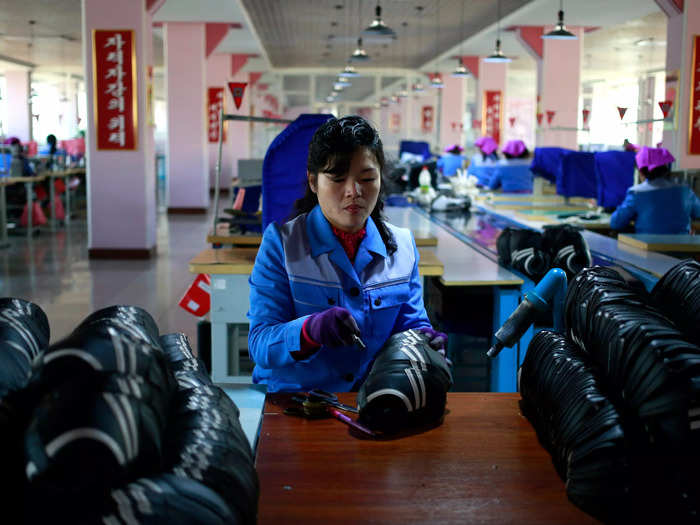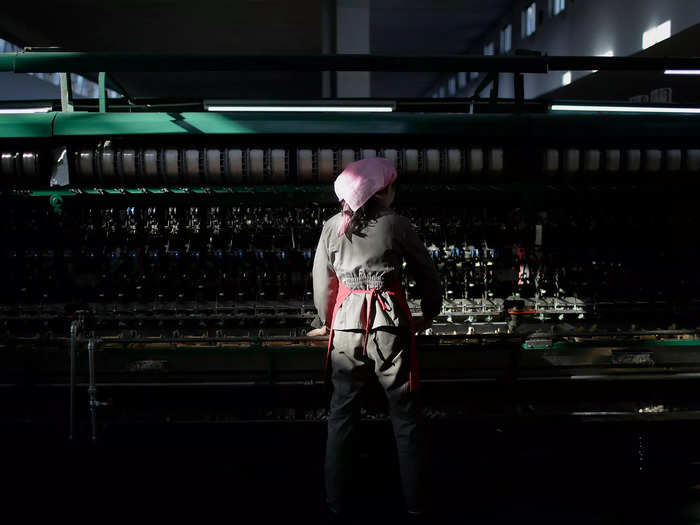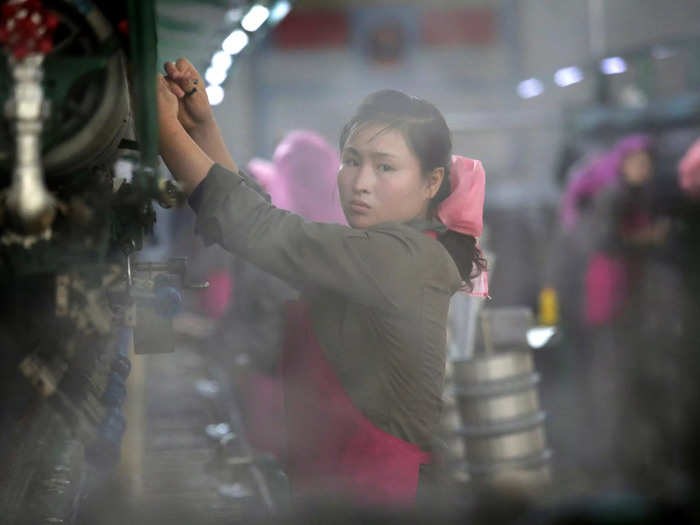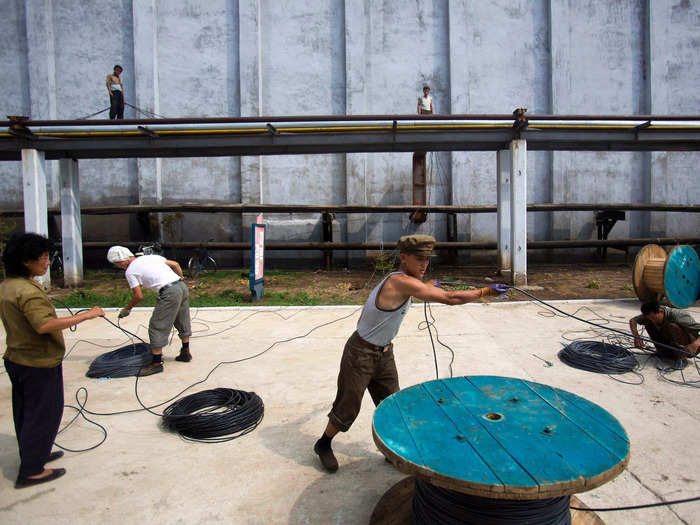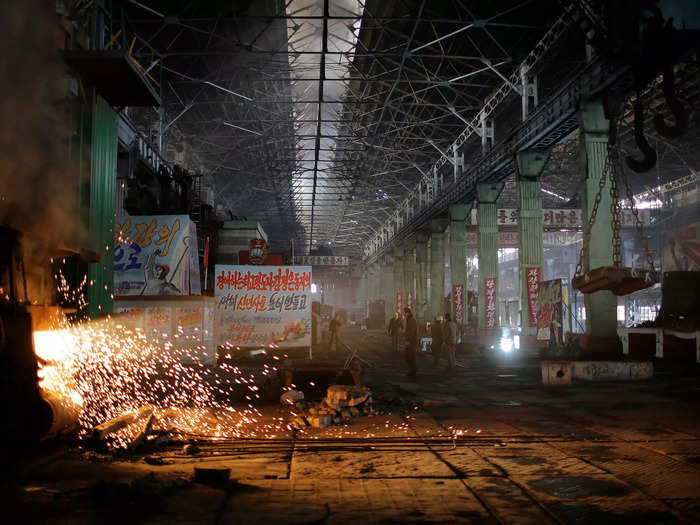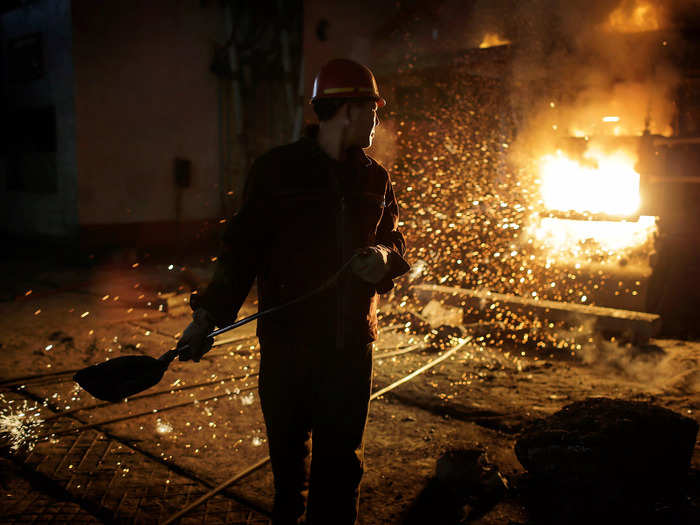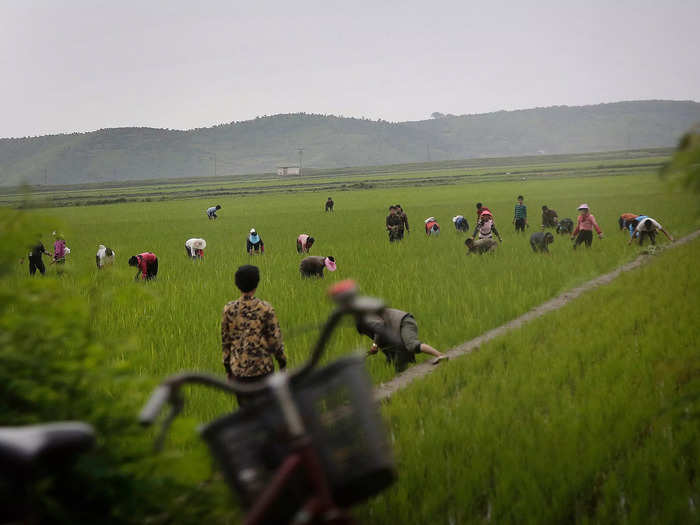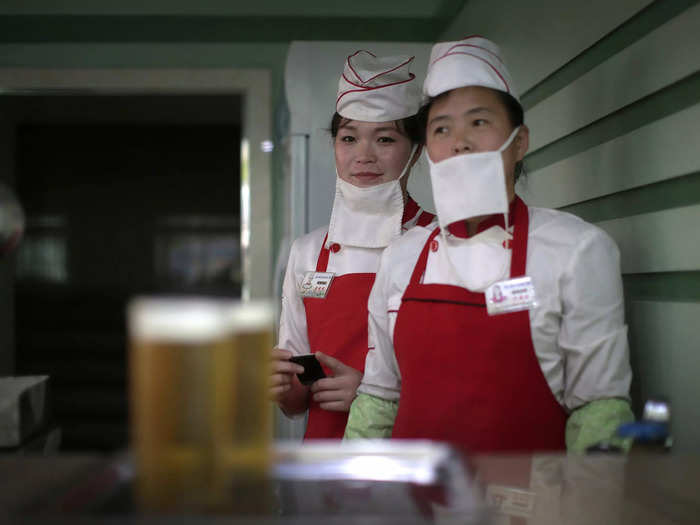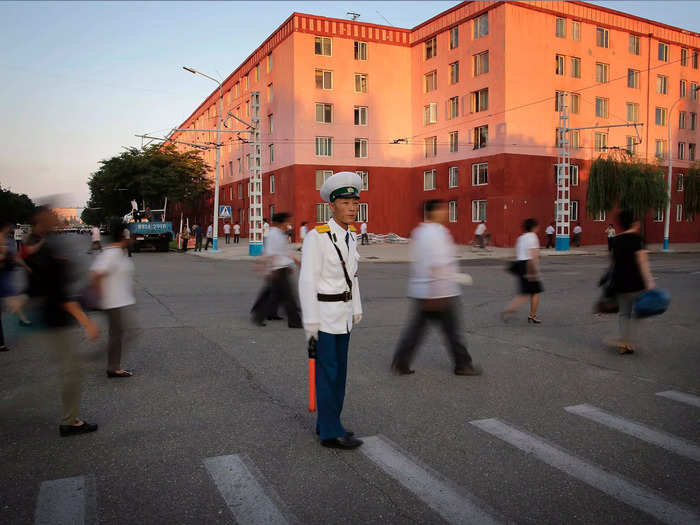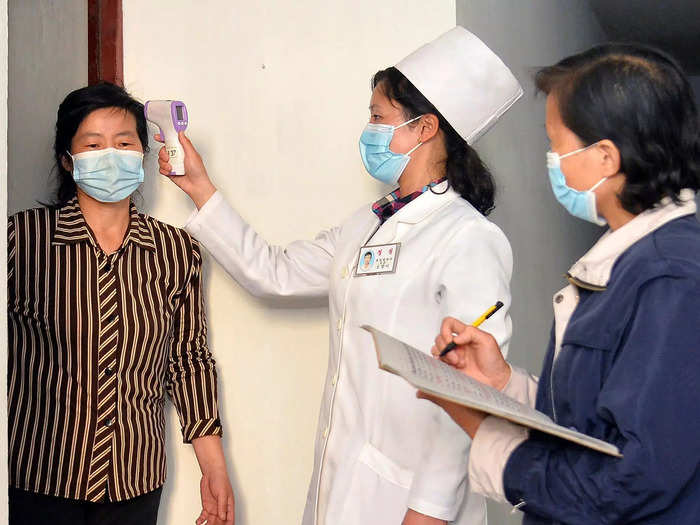Song Un Pyol, manager at the upscale Potonggang department store in Pyongyang, North Korea, stands in the snacks aisle while being interviewed by The Associated Press on June 19, 2017. Three generations into the ruling dynasty begun by Kim Il Sung, markets have blossomed and a consumer culture is taking root.AP Photo/Wong Maye-E, File
- North Korea is home to over 25 million people, who are taught to worship their leaders, like Kim Jong Un, as gods.
- The country is culturally and economically isolated, as many people in North Korea suffer from malnutrition and live in extreme poverty.
Little is known about the daily life of people living in North Korea, one of the world's most isolated nations.
The country is home to more than 25 million people, who from a young age are taught to worship their leaders, including the current Great Leader, Kim Jong Un, as powerful gods. Un has near-total control of the country, and heads up a repressive regime that makes no bones about doing away with political dissidents
And while Kim boasts his great military and nuclear might to the rest of the world, many of his citizens quietly struggle, suffering from malnutrition and poor living conditions. Most citizens have little idea of what's going on in the outside world due to government restrictions on electricity, travel, and more.
Still, North Korean citizens do participate in the workforce, though sometimes they do so against their will. Most North Koreans don't have a say in their professions and are assigned a job. According to the Foundation for Economic Education, around 100,000 North Koreans work in forced hard labor camps on infrastructure projects.
Below, take a look into the mostly hidden world of the work-life of North Korea.
Following a catastrophic famine in the 1990s, North Korea pushed to increase its agricultural production. Still, food insecurity in the region is alarmingly high, the UN recently said.
A farmer carries a fully grown cabbage after plucking it out from the main crop that will be harvested early next month and used to make Kimchi, at the Chilgol vegetable farm on the outskirts of Pyongyang, North Korea, on Oct. 24, 2014. AP Photo/Wong Maye-E, File
The country was receiving food aid until 2009, and in recent years, corn and rice production has improved.
Source: Associated Press
Around 37 percent of all North Koreans work in agriculture and use primitive methods to cultivate the land.
Men plow fields along the Pyongyang-Wonsan highway in Sangwon, North Korea, near Pyongyang, on July 20, 2017. AP Photo/Wong Maye-E, File
North Korea's disdain for modern technological intervention is in part a way to add more laborers to the workforce. More machines would mean fewer workers.
Source: Associated Press
Source: CIA World Factbook
Workers at Ongnyugwan, a popular noodle restaurant in Pyongyang, claim to serve 10,000 lunches a day. The restaurant was built in 1960 at the request of the late leader Kim Il Sung.
People dine at the Ongnyugwan, a popular noodle restaurant in Pyongyang, North Korea, on Sept. 1, 2014. AP Photo/Wong Maye-E, File
Kim Jong Il opened the Pothonggang Department Store in December 2010 in what officials said was an attempt to improve living conditions in Pyongyang, North Korea's capital. The store sells electronics, cosmetics, food, housing goods, and more.
Song Un Pyol, manager at the upscale Potonggang department store in Pyongyang, North Korea, stands in the snacks aisle while being interviewed by The Associated Press on June 19, 2017. AP Photo/Wong Maye-E, File
While comparatively wealthy North Koreans line up to shop at the store, poorer city residents instead buy goods via an extensive black market — often trading American dollars for products.
Source: Reuters
Citizens are encouraged by the state to purchase domestically made cosmetics instead of foreign brands.
North Korean women package soap at a cosmetics factory in Pyongyang, North Korea, on Saturday, Jan. 12, 2013. David Guttenfelder/AP
The 326 Electric Wire Factory in Pyongyang says it has 1,000 workers on any given day. When the Los Angeles Times visited in 2016, only 100 were on duty.
A factory worker takes off his gloves at the Pyongyang 326 Electric Wire Factory in Pyongyang, North Korea, on Jan. 10, 2017. AP Photo/Wong Maye-E, File
North Korea has one major trading partner — China — to whom they sell minerals, metals, guns, textiles, and agricultural and fishery products
A hotel staff member stands at a reception desk decorated with a map of the world on Oct. 23, 2014, in Pyongyang, North Korea. AP Photo/Wong Maye-E, File
Images of the first Great Leader, Kim Il-Sung, and his son, Kim Jong Il, can be found throughout the country. This portrait adorns the wall of a hotel in Pyongyang.
A staff member sweeps the floor in a hotel lobby in front of a portrait of the Great Leaders. AP Photo/Wong Maye-E, File
The Kim Jong Suk Pyongyang textile factory, named after North Korean leader Kim Jong Un's grandmother, claims to employ 1,600 workers, primarily women.
A woman works at the Kim Jong Suk Pyongyang textile factory in Pyongyang, North Korea, on July 31, 2014.fs AP Photo/Wong Maye-E, File
At the Ryuwon Shoe Factory, Kim Kyong Hui said "the respected leader Kim Jong Un has instructed us to closely study shoes from all over the world and learn from their example."
A North Korean woman works at Ryuwon Shoe Factory, which specializes in sports footwear, in Pyongyang, North Korea, Friday, Feb. 1, 2019. Dita Alangkara/AP
At the Suk Pyongyang textile factory, employees sort and process silkworms to produce silk threads.
A shaft of light from the morning sun illuminates a woman as she sorts out silkworm cocoons to be boiled at the Kim Jong Suk Silk Mill in Pyongyang, North Korea, on Jan. 6, 2017. AP Photo/Wong Maye-E, File
The Suk Pyongyang textile factory in Pyongyang has said that it produces about 200 tons of silk every year.
A woman sorts silkworm cocoons to be boiled as part of the silk production process at the Kim Jong Suk Silk Mill in Pyongyang, North Korea, on Jan. 6, 2017. AP Photo/Wong Maye-E, File
North Korea has historically struggled to produce the amount of fertilizer it needs.
North Korean laborers work together at a fertilizer factory in Hamhung, North Korea's second largest city in South Hamgyong Province, Friday, Aug. 10, 2012. David Guttenfelder/AP
The Chollima Steel Complex in Nampo says it employs more than 8,000 workers. It's one of seven North Korean steel complexes.
A shaft of light from a furnace shines through the Chollima Steel Complex in Nampo, North Korea, on Jan. 7, 2017. AP Photo/Wong Maye-E, File
The Chollima Steel Complex was built by Mitsubishi when Japan ruled over the Korean Peninsula from 1910 to 1945. Production briefly stopped after World War II but resumed in 1953.
A worker with a shovel stands near a furnace at the Chollima Steel Complex in Nampo, North Korea, on Jan. 7, 2017. AP Photo/Wong Maye-E, File
Men and women work together in rice fields in North Korea's Kangwon Province. The province's capital, Wonsan, is being developed into a summer vacation destination.
Men and women work in a rice field in Kangwon province, eastern North Korea, on June 23, 2016. AP Photo/Wong Maye-E, File
The state-owned Taedonggang Beer company has a shop in Pyongyang, where people can stop in for a drink.
Beer servers Kim Yon Hui, left, and Yang Pok Yong wait to serve customers at the Taedonggang Beer shop in Pyongyang, North Korea, on May 7, 2016. AP Photo/Wong Maye-E, File
It's nearly impossible to buy beer outside of North Korea, but it can be found in some parts of China.
Source: Associated Press
The prices of corn and rice products increased amid the pandemic.
An employee of the Pyongyang Corn Processing Factory watches corn noodles being made Thursday, Dec. 10, 2020, in Pyongyang, North Korea. Jon Chol Jin/AP
Laborers in Rajin export seafood products to China at the Suchae Bong Corp seafood factory inside the Rason Special Economic Zone.
Workers carry boxes of seafood on Nov. 8, 2013, as they load a Chinese transport truck at the Suchae Bong Corp seafood factory in Rajin, North Korea, inside the Rason Special Economic Zone. AP Photo/David Guttenfelder, File
North Koreans are allowed to work in China, and some do work at Chinese companies within North Korea. But they do so at a price: Kim Jong Un's government takes a cut each worker's salary.
Source: Associated Press
The Kaesong Industrial Complex in Kaesong, North Korea, is the last inter-Korean rapprochement project. Though it is located in North Korea, just across the demilitarized zone from South Korea, the factory was first built as a place where South Korean companies could manufacture products using North Korean labor.
Workers check finished products at the factory of a South Korean-owned company at the jointly-run Kaesong Industrial Complex in Kaesong, North Korea, on Dec. 19, 2013. The Kaesong complex just north of the border is the last remaining inter-Korean rapprochement project. Kim Hong-Ji/Pool Photo via AP, File
Officers in the Ministry of Public Security — North Korea’s daily law-enforcement agency — functions as a national constabulary who enforce laws.
A traffic policeman directs pedestrians leaving an anti-U.S. rally that marked the 66th anniversary of the start of the Korean War at Kim Il Square in Pyongyang, North Korea, on June 25, 2016. AP Photo/Wong Maye-E, File
In May 2022, Kim Jong Un blamed his own officials and their "irresponsible work attitude" for a surge in COVID-19 infections.
In this photo provided by the North Korean government, a doctor checks a resident's temperature to curb the spread of coronavirus infection, in Pyongyang, North Korea on May 17, 2022. Korean Central News Agency/Korea News Service via AP, File

